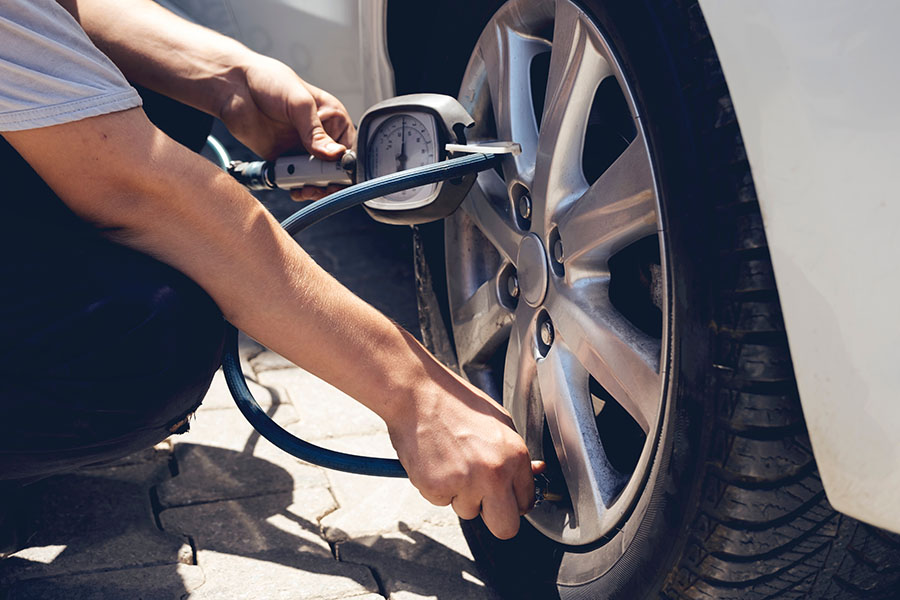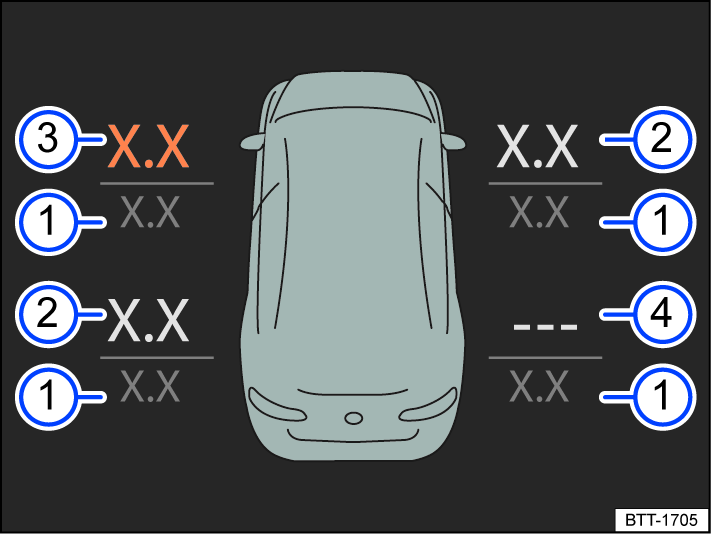VW Arteon is equipped with Tire Pressure Monitoring System (TPMS) for the purpose of warning the driver when one or more of the tires are significantly under-inflated, creating a potentially unsafe driving condition. In this article we discuss the reasons for the amber colored TPMS warning light in Arteon, and how you can reset it.

The TPMS warning light illuminates in VW Arteon when air pressure is low in one or more of the tires, battery has depleted in a pressure sensor, TPMS receiver module has malfunctioned, or a pressure sensor has been damaged.
Low tire pressure
When the amber colored TPMS warning light  turns on in your Arteon, stop your vehicle when it is safe to do so and check tire pressure on all the wheels, including the spare wheel (if your vehicle has one). Driving on a significantly under-inflated tire causes the tire to overheat and can lead to tire failure.
turns on in your Arteon, stop your vehicle when it is safe to do so and check tire pressure on all the wheels, including the spare wheel (if your vehicle has one). Driving on a significantly under-inflated tire causes the tire to overheat and can lead to tire failure.

Reinflate the tires
Reinflate all the tires of your Arteon to the manufacturer specified air pressure, which is mentioned on the vehicle placard or tire inflation pressure label usually located on the B-pillar or the edge of the driver door. If you can’t find the label, check the size of your tire which is mentioned on the sidewall of the tire, and match it to the tire pressure information shown below. These are official cold tire pressure values for Arteon from Volkswagen.
Arteon front wheel drive
- 245/45 R18 96H: 32 psi
- 245/40 R19 94H: 35 psi
- 245/35 R20 95H: 38 psi
Arteon all-wheel drive (4MOTION)
- 245/45 R18 96H: 35 psi
- 245/40 R19 94H: 38 psi
- 245/35 R20 95H: 42 psi
Spare wheel
- T125/70 R18: 60 psi

Resetting the TPMS warning light
After you have inflated all the tires to the correct air pressure, the TPMS warning light will turn off automatically when the vehicle is driven for a few miles. VW Arteon uses the direct method for monitoring tire pressure, which means a pressure sensor actively records the internal pressure and air temperature of the tire on each wheel. There is no need to reinitialize the TPMS system in order to reset the warning light. There is no reset button like the one you see in vehicles with indirect TPMS system which uses ABS sensors to detect low tire pressure.
If the low tire pressure light does not turn off automatically after reinflating the tires in your Arteon, increase the tire pressure by 5 psi on top of the factory recommended value, and drive your vehicle for at least 10 miles (16 km). After the TPMS warning light turns off, and the vehicle has been parked for a few hours, reduce the tire pressure to the factory recommended value.
Chilly weather can turn on low tire pressure light in Arteon
Cold weather is one of the most common cause for low tire pressure warning light in VW Arteon. When analyzing WheelsJoint’s statistical data, it has been observed that there is sharp rise in the number of searches for TPMS warning light causes at the start of every winter season, about three times higher as compared to mid summer season.

The air, like most other substances, expands when heated and contracts when cooled. So when the weather gets colder, the tire pressure decreases, which could trigger TPMS warning light in Arteon. The tire pressure will vary with temperature by about 1 psi (7 kPa) for every 12°F (6.5°C).

Inflate tires when cold
Tire pressure in Arteon should always be set based on cold inflation tire pressure. This is defined as the tire pressure after the vehicle has not been driven for at least three hours, or driven less than 1 mile (1.6 km) after a three-hour period.
Do not adjust tire pressure when hot
The tires on your Arteon can get around 50 degrees hotter than the outside temperature when you’re driving, which increases the tire pressure by about 4 psi – this is normal and there should be no adjustment for this increased pressure.
Does altitude affect tire pressure?
Yes, altitude can change tire pressure values, but it is negligible and not a cause for concern. If you drive your Arteon from sea level to Mount Evans Scenic Byway in Colorado which is the highest paved road in North America at the altitude of 14,130 feet (4,307 m), the tire pressure should theoretically increase by approximately 6 psi. But, the decrease in ambient temperature at higher elevation contracts the air in tires and compensates for any altitude pressure changes.
Is it safe to drive Arteon with low tire pressure?
The driving characteristics of Arteon change even if the air pressure is 5 psi less than manufacturer’s recommended value: the braking distance can be longer, cornering worse, and at particularly high speeds there is even a risk that the tire will burst. Low tire pressure also increases tire wear, and the higher rolling resistance of the tire means higher fuel consumption. So it is recommended to reinflate the tires to the correct pressure as soon as possible.
Dead battery in a tire pressure sensor
Each tire pressure sensor in Arteon is powered by a built-in lithium-ion battery. When the battery is depleted, the sensor stops transmitting tire pressure information to the receiver module. When this happens, the TPMS warning light will flash every time the engine is started, and will remain illuminated until you turn off the vehicle.

How long do the pressure sensor batteries last?
The tire pressure sensor batteries usually last anywhere from 5 to 10 years in Arteon. When the battery is depleted, you must replace the sensor itself, as the battery is sealed into the sensor unit and is non-replaceable.
Identifying a faulty pressure sensor
The most reliable method for detecting a faulty tire pressure sensor or a sensor with dead battery is by testing each sensor with a scan tool. For example, MaxiTPMS TS408 is commonly used for diagnosing and programming tire pressure sensors. A sensor that is not detectable by the scanner is most likely defective and should be replaced with a new one.

If you don’t want to spend over a hundred bucks on a scanner, then head over to any reputable tire shop and perform a TPMS diagnostic scan of your Arteon. Some shops like Discount Tire and Pep Boys offer free of charge TPMS diagnostic services.
Installed new tires?
If a pressure sensor stopped responding after you installed new tires on your Arteon, it is possible the sensor got damaged during tire installation. These sensors are quite sensitive, and can be easily damaged if utmost care is not taken while changing tires.
VW Arteon TPMS user guide
The TPMS system in this vehicle monitors tire pressures using pressure sensors on every tire valve (direct measurements). The tire valves are made of metal.
The reference pressure for the Tire Pressure Monitoring System is the recommended tire pressure for the tires installed at the factory when the tires are cold at maximum load. The reference pressure corresponds to the details on the tire pressure label.
The Tire Pressure Monitoring System may not react at first or may not react at all when you are driving in a sporty manner, or on snow-covered or unpaved roads, when you are driving with snow chains, or in certain other situations. A change in the tread circumference of a tire is signaled by the Tire Pressure Monitoring System indicator in the instrument cluster (telltale).
The tire pressure recommended for the tires originally installed on the vehicle is on a sticker on the driver door jamb.
Each tire, including the spare (if provided), should be checked monthly when cold and inflated to the inflation pressure recommended by the vehicle manufacturer on the vehicle placard or tire inflation pressure label. (If your vehicle has tires of a different size than the size indicated on the vehicle placard or tire inflation pressure label, you should determine the proper tire inflation pressure for those tires).
As an added safety feature, your vehicle has been equipped with a tire pressure monitoring system (TPMS) that illuminates a low tire pressure telltale when one or more of your tires is significantly under-inflated. Accordingly, when the low tire pressure telltale illuminates, you should stop and check your tires as soon as possible, and inflate them to the proper pressure. Driving on a significantly under-inflated tire causes the tire to overheat and can lead to tire failure. Under-inflation also reduces fuel efficiency and tire tread life, and may affect the vehicle’s handling and stopping ability.
Please note that the TPMS is not a substitute for proper tire maintenance, and it is the driver’s responsibility to maintain correct tire pressure, even if under-inflation has not reached the level to trigger illumination of the TPMS low tire pressure telltale.
Your vehicle has also been equipped with a TPMS malfunction indicator to indicate when the system is not operating properly. The TPMS malfunction indicator is combined with the low tire pressure telltale. When the system detects a malfunction, the telltale will flash for approximately one minute and then remain continuously illuminated. This sequence will continue upon subsequent vehicle start-ups as long as the malfunction exists.
When the malfunction indicator is illuminated, the system may not be able to detect or signal low tire pressure as intended. TPMS malfunctions may occur for a variety of reasons, including the installation of replacement or alternate tires or wheels on the vehicle that prevent the TPMS from functioning properly. Always check the TPMS malfunction telltale after replacing one or more tires or wheels on your vehicle to ensure that the replacement or alternate tires and wheels allow the TPMS to continue to function properly.
Tire pressure display in the instrument cluster

- Specified pressure in psi.
- Actual pressure in psi.
- Loss of pressure in the left front tire.
- System malfunction in the right rear tire.
When the ignition is switched on, the display initially shows the tire pressures that were last read by the system. When you begin driving, the display will update. If there is low tire pressure, the actual values and the affected tires will be marked in the display.
The sensors do not send any tire pressures when the tires are not moving. This helps to conserve the sensor batteries.
If no tire pressures are sent, the last tire pressures received will be shown in grey.
Switching the tire pressure monitoring system on or off (depending on the vehicle)
Follow the local applicable legal regulations regarding the tire pressure monitoring system.
If a tire set that does not contain wheel sensors or whose wheel sensors are not compatible with the vehicle is installed, the indicator  light will blink for about one minute and then stay on. The tire pressures will not be monitored. It is not possible to switch the system off.
light will blink for about one minute and then stay on. The tire pressures will not be monitored. It is not possible to switch the system off.
Adapting tire pressures
The tire pressure must be checked and adapted each time the vehicle load changes. The tire pressure that is recommended for the vehicle is located on a label on the driver’s door pillar or on the inside of the fuel filler flap. The values read by the pressure gauge when inflating the tire may differ from the values detected by the TPMS. The TPMS is more accurate!
Selecting tire type
When changing to a tire in a different size, it may be necessary to adapt the specified pressure of the Tire Pressure Monitoring System to the new tires. Contact an authorized Volkswagen dealer or authorized Volkswagen Service Facility to do so. Volkswagen recommends contacting an authorized Volkswagen dealer or authorized Volkswagen Service Facility.
If tires in a size that was not intended at the factory are installed, the specified pressure for these tires can be set by an authorized Volkswagen dealer or authorized Volkswagen Service Facility. Volkswagen recommends contacting an authorized Volkswagen dealer or authorized Volkswagen Service Facility.
Spare wheel, compact spare wheel, or collapsible spare wheel
The pressure of the spare wheel, compact spare wheel, or collapsible spare wheel in the vehicle trunk is not monitored.
- The pressure sensors are installed on special aluminum valves that are fixed in place. When filling and checking the tire pressure, do not bend the valves “into position”.
- The valves and sensors can be damaged if valve caps are missing. For this reason, always make sure all valve caps are fully tightened when driving. Do not use metal valve caps.
- Do not use “comfort valve caps”, because these do not form a seal and the sensors could be damaged.
Warnings!
- The intelligent technology of the Tire Pressure Monitoring System (TPMS) cannot overcome the natural laws of physics and it can only operate within the limits of the system. Handling wheels and tires incorrectly can result in a sudden loss of tire pressure, tread separation, and ruptured tires.
- Check the tire pressure regularly and always maintain the specified values. If the tire pressure is too low, the tire can heat up so much that the tread separates or the tire ruptures.
- Always inflate the tires to the correct tire pressure when the tires are cold according to the tire inflation pressure label.
- Check the tire pressure regularly when the tires are cold. If necessary, adjust the tire pressure when the tires are cold so that it is suitable for the tires installed on your vehicle.
- Check the tires regularly for signs of wear or damage.
- Never exceed the maximum permissible speed and tire load specified for the tires fitted to your vehicle.
- Different tire pressures or low tire pressure can cause tire damage, tire failure, loss of vehicle control, crashes, serious injuries, and death.
- If the warning light turns on, stop the vehicle immediately and check all of the tires.
- Different tire pressures or low tire pressure can increase tire wear, decrease vehicle stability, and increase braking distance.
- The driver is responsible for maintaining the correct tire pressure in all tires on the vehicle. The recommended tire pressure can be found on a label.
- The Tire Pressure Monitoring System (TPMS) can only function correctly when all tires are inflated to the correct pressure when they are cold.
- All tires must always be inflated to the correct pressure based on the load.
- Inflate all tires to the correct tire pressure before every drive.
- When the tire pressure is too low, the tire must flex more when driving. This could cause the tire to become so hot that the tread could separate, the tire could rupture, and you could lose control of the vehicle.
- Driving at high speeds and excessive vehicle load can cause a tire to become so hot that the tire could rupture and you could lose control of the vehicle.
- Tire pressure that is too high or too low shortens the service life of the tire and affects driving behavior.
- If the tire is not “flat” and the tire does not need to be replaced immediately, drive slowly to the nearest authorized Volkswagen dealer or authorized Volkswagen Service Facility to have the tire pressure checked and corrected. Volkswagen recommends contacting an authorized Volkswagen dealer or authorized Volkswagen Service Facility.
Reset the entire system
If the low tire pressure warning light won’t turn off due to a glitch in the tire pressure monitoring system, it may be possible to reset the TPMS system by resetting all on-board computers in your Arteon. This method should only be considered as a last resort, when all else fails.

You can reboot all the on-board computers by disconnecting the main 12 volt battery for a few minutes. Remove the cable from the negative terminal of the battery first, then from the positive terminal. With the battery disconnected, press the horn button a few times and turn on the headlights to drain out all the residual electricity from the system. After about 15 minutes, reconnect the battery in reverse order: positive cable first, then negative cable.
Tire pressure keeps getting low
If the TPMS warning light turns on frequently in your Arteon, and the tire pressure is also decreasing after you have reinflated the tires, there may be an air leak. One or more of the tires may have been punctured by an external object, or the air may be leaking from a defective value stem.

Can I disable the TPMS system in Arteon?
No, the TPMS system is federally mandated, and cannot be disabled in VW Arteon. All vehicles must have a working tire pressure monitoring system to be legally compliant.
Use OBD2 scanner for diagnosis
Since VW Arteon is equipped with on-board diagnostics (OBD), a fault diagnosis can provide initial indications of where the malfunction is located. But when it comes to TPMS, a basic code reader will not suffice. You will need an advanced scanner to monitor TPMS data or read TPMS codes.

BlueDriver is a commonly used scanner by DIYers that can read TPMS codes for most vehicles and isn’t too expensive – costs about a hundred bucks. You can also clear the TPMS fault codes with this device which will turn off the warning light, but the light may come back on if the on-board diagnostic system detects a fault again.



